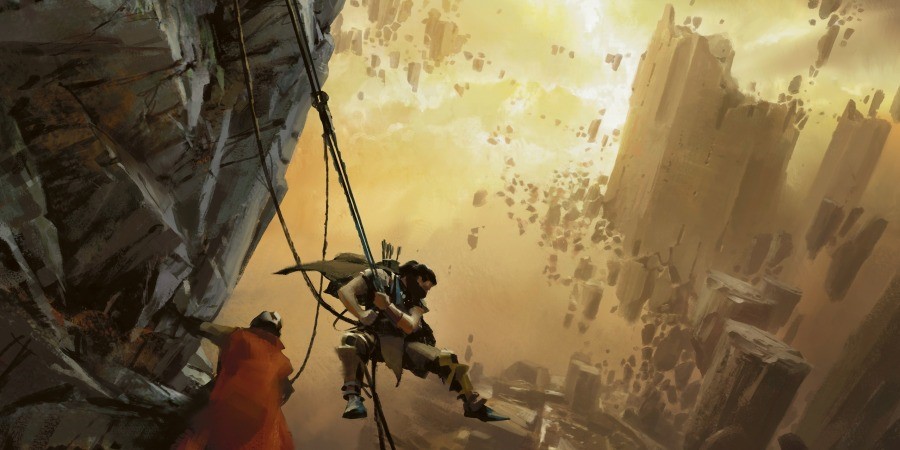White magic flows through the veins of Commander, infusing decks with purity, resilience, and an unwavering sense of justice. When it comes to harnessing the power of White, the choice of lands can significantly impact your ability to execute flawless strategies and achieve victory. But what are some great examples of some of the best white lands for Commander?
Some, like Serra’s Sanctum and Hall of Heliod’s Generosity, are well known to work with White’s affinity for enchantment cards, offering mana acceleration and recursion options, respectively. Others, like Kor Haven and Eiganjo, Seat of the Empire, see more general play for their ability to stand up to attackers and protect your life total.
Exploring the intricacies of these magnificent lands is a journey that every passionate Planeswalker should undertake, so let’s delve into the depths of the best white lands for Commander, uncovering their hidden potential, and unveiling the strategies you might employ them for.
But before that, as White’s landscape is as captivating as it is vast, let’s look at what sets the good lands apart in Commander so you know what traits to look when choosing cards for your decks.
Getting To Know Basic And Nonbasic Lands
Lands are the foundation of any game of Magic: The Gathering (MTG), so choosing the right ones for your Commander deck is crucial. This is because lands are your source of mana, which you need to cast your spells and activate your abilities. But not all lands pack the same punch, so let’s quickly cover the 2 types in MTG: basic and nonbasic.
- Basic lands are the simplest and most common in the game, and they come in six choices: Plains, Island, Swamp, Mountain, Forest, and Wastes. Each basic land taps for one mana of a specific color (except Wastes, which taps for colorless): white, blue, black, red, and green. You can have any number of basic lands in your deck as long as they match your Commander’s color identity.
- Nonbasic lands are more complex and diverse than basic lands, as they have different names and abilities and can often tap for more than one mana or multiple colors of mana. Nonbasic lands can also provide utility, such as drawing cards, gaining life, synergizing with specific types of cards (such as enchantments, artifacts, or tokens), or destroying permanents.


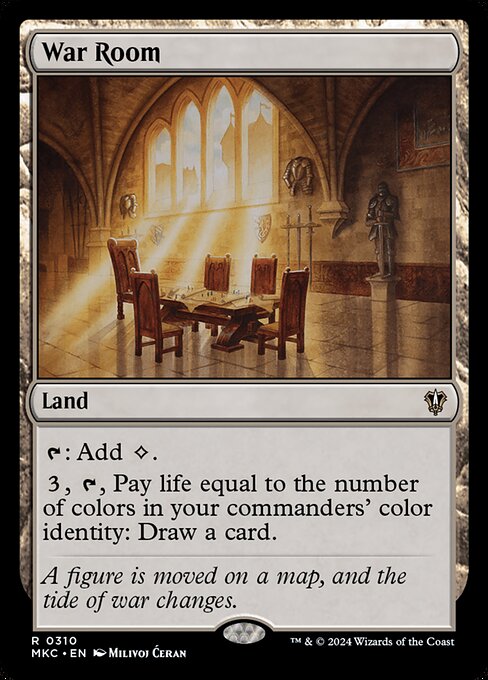
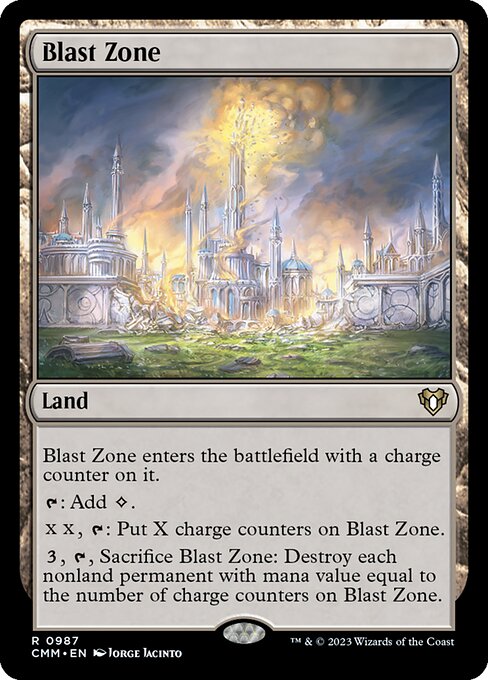
However, playing nonbasic lands in Commander also has some drawbacks. Three examples include
- Nonbasic lands are more vulnerable to land destruction or hate cards, such as Blood Moon, Thalia and The Gitrog Monster, or Back to Basics, which can shut down their abilities, force them to enter or stay on the battlefield tapped, or change the colors of mana they tap for.
- Nonbasic lands are also affected by color identity rules, which limit what lands you can play in your deck based on your Commander’s colors. For example, you can’t play a Temple Garden in a mono-green deck, even though it taps for green mana.
- High prices and scarcity can make certain nonbasic lands pretty hard to acquire, especially for older or rarer lands that have high demand and low supply.
So why play nonbasic lands in Commander? The answer is simple: because they offer more options and advantages than basic lands. Nonbasic lands can help you fix your mana, ramp up your resources, enhance your gameplay, support your strategy, and make your deck more fun and interesting to play with and against!
Choosing Nonbasic White Lands In Commander
As you may know, White is often considered the weakest color in Commander, as it lacks card draw, ramp, and interaction compared to other colors. However, white has access to some of the best nonbasic lands in the game, which can help you overcome some of its weaknesses and enhance some of its strengths.
What separates a good nonbasic land from a mediocre one though? Here are some of the things I look for when choosing nonbasic lands for my White decks:
- Can the land enter the battlefield untapped? Commander has evolved to become a much faster format than it was over a decade ago, so it has become infinitely more important to have immediate access to your land’s mana as soon as you play it.
If I have to pay a little life to do so, as with Sacred Foundry or Emeria, Shattered Skyclave, so be it – when you have 40 life to work with, that’s a negligible price most of the time. - Does my land provide utility? Can my land do more than add mana to my mana pool? If so, do I have to invest a lot of resources to use that ability? That second question is what separates the Kor Havens from the Mystifying Mazes when considering lands for my decks, as an ability that costs 2 mana to activate will be much easier to hold mana up for than one that costs 4.
Both questions matter, but you really have to look at both thoroughly to determine whether a land truly provides utility in your deck, or simply looks like it does. - Does my land tap for more than one mana or multiple colors of mana? If you have a multicolor commander, this is definitely where you start looking through good dual lands for your Commander deck, or you start pulling lands like Command Tower that tap for any color in your commander’s color identity.
Lands like Ancient Tomb or Nykthos, Shrine to Nyx can also be major boons, as they have the ability to tap for 2 or more mana. This can help you keep pace with opposing green mana ramp spells, or in the case of Nykthos, surpass them after you’ve made a few early plays. - Will my land have the ability to influence table politics? Maze of Ith is the land I immediately think of here, as it doesn’t tap for mana, but can remove any attacking creature from combat each time it is used. That said, you can also use cards like Mikokoro, Center of the Sea to make friends by giving everyone access to what they want most – more cards!
- Does my land synergize with my other cards? Synergy can make a land that looks terrible everywhere else really shine in the right deck. For example, in my Karlov of the Ghost Council deck, I use a lot of lands like Kabira Crossroads and Scoured Barrens that I’d recommend almost nowhere else because they provide a free boost to my commander simply by playing the game.
Inventors’ Fair is another great example for artifact decks, as it lets you tutor for an artifact so long as you have 3 in play and don’t mind giving up a land. At instant speed no less – now that’s what I call value!
Beyond Basics: Unearthing The Top White Lands For Commander
You’ve seen the ups and downs of White mana in Commander; now let’s get to the good stuff and check out the best white lands for this format. We’ve carefully sorted these lands from meh to wow based on how powerful, flexible, and accessible they are, roughly going from least to most awesome.
Also of note – these cards will be strictly White in terms of color identity, in order to make sure you don’t have to account for specific combinations of colors when considering them for your Commander deck (though we’ll still discuss notable multicolor strategies).
Ancient Den: The Metal Citadel

Good for: Artifacts Matter, Artifact Reanimation, Affinity for Artifacts
Ancient Den may look like a humble land that taps for 1 white mana, but its artifact supertype is so powerful, we’ve not seen an artifact land that enters untapped and taps for colored mana since the cycle it was featured in.
While I typically see this in artifact-centric decks like Sharuum the Hegemon that are looking to optimize value from all the best artifact colors, I’ve had a lot of success with this card as a ramp effect in my Osgir the Reconstructor deck as well. Pitch the land through a Faithless Looting, tap Osgir for 0, and you’re up 2 mana without spending your land drop for the turn.

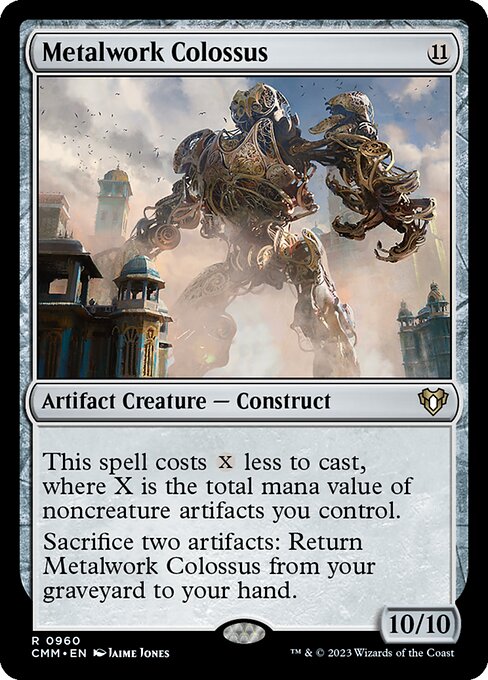

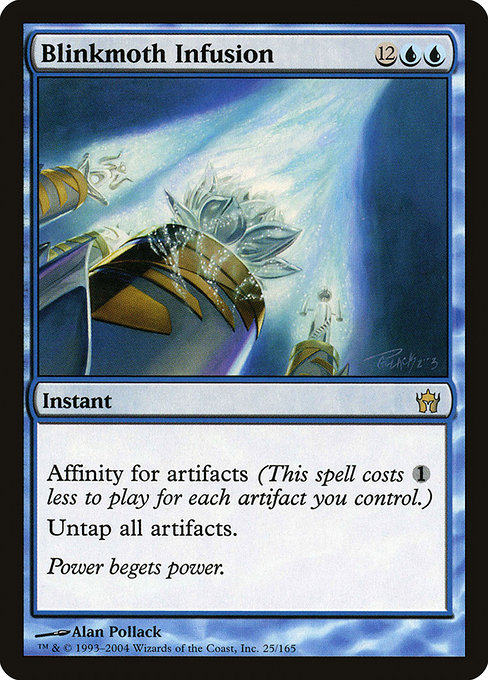
As you can see, those commanders are only the tip of the iceberg, as there are plenty of other useful synergies artifact lands like Ancient Den can contribute to. It may be a little unconventional as a nonbasic land, but if you have enough ways to tinker with your artifacts for value, this land’s vulnerability to artifact removal can be more than made up for with minimal effort.
Flagstones Of Trokair: The Sacred Quarry
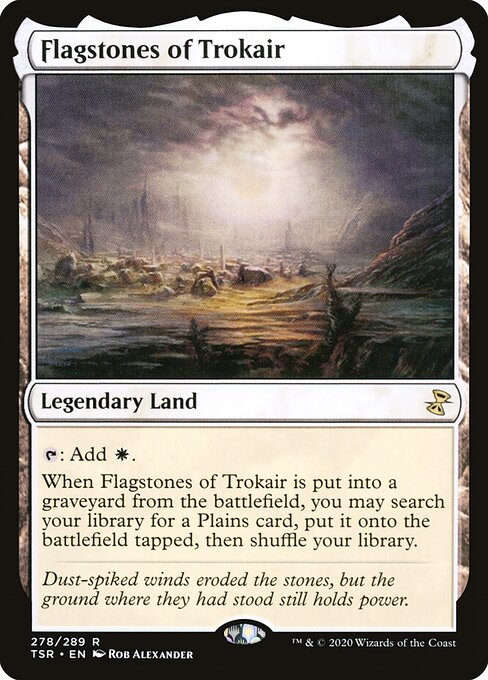
Good for: Landfall, Sacrifice Themes, Graveyard Shenanigans, Copy Effects
Flagstones of Trokair was a bit of an odd duck when it came out in Time Spiral. It’s a legendary nonbasic land that lets you search your library for a Plains card and place it onto the battlefield tapped when it’s put into the graveyard from the battlefield.
Yes, any Plains. Go get those Indatha Triomes and Hallowed Fountains and fix that mana!
Originally abused with Vesuva in its Standard days, this mechanic is pretty valuable, allowing you to abuse the legend rule to fix your mana while thinning your deck. More ways to abuse this card have come out in the years since, so to name a few:
- You can easily double up on landfall triggers like Felidar Retreat (effects that go off when a land enters the battlefield)
- You can abuse this with cards like Thalia and The Gitrog Monster to turn what should be a cost into a benefit
- You can ensure guaranteed land drops or ramp every turn in conjunction with cards like Crucible of Worlds and Undergrowth Recon, so long as you have a way to keep a 2nd copy of the Flagstones around.
These perks make Flagstones of Trokair not only a steady white mana producer, but also a sneaky way to set up cards that cheat lands back from the graveyard, helping you stay ahead in fun and profit while keeping your mana pool full.
Windbrisk Heights: The Hidden Treasure

Good for: Cheating Out Big Spells, Surprise Attacks, Value Plays
Windbrisk Heights may enter the battlefield tapped, but it can hide away a card from the top 4 of your library and let you cast it for a single white mana later. This lets you effectively draw a card later in the game while also letting you sneak out powerful spells that would normally cost a lot of mana like Avacyn, Angel of Hope or Approach of the Second Sun.
All for the low, low price of attacking with three or more creatures, which shouldn’t be too hard in the color best known for producing lots of efficient creatures.
While a great nonbasic land to play in the early turns of the game, as your opponents will usually forget about it, Windbrisk Heights can also be a good setup piece in conjunction with commonly played topdeck manipulators like Scroll Rack and Sensei’s Divining Top, giving you a bit more forewarning and/or control of your destiny instead of simply leaving things to chance.
I’ll admit, this land isn’t always the most reliable one on the list without some help, but it definitely adds an element of excitement and mystery to your deck and can help you pull off some stylish plays, making Windbrisk Heights one of the most fun nonbasic white lands.
Hall of Heliod’s Generosity: The Enchantment Recycler

Good for: Enchantment Strategies, Voltron, Pillow Fort
I’m always a little leery of nonbasic lands that don’t tap for colored mana, but Hall of Heliod’s Generosity does two things I like. First, it enters the battlefield untapped. Second, it can also put an enchantment card from your graveyard on top of your library, meaning that you can reclaim your favorite enchantments that were destroyed or discarded and cast them again.
While this makes the types of decks this legendary land is good in pretty obvious, I’ll say this anyway: Hall of Heliod’s Generosity is perfect for decks that rely on enchantments to win the game, whether it’s by using Auras to buff a single creature, preventing attacks through effects like Ghostly Prison, or stripping value from opponents via effects like Planar Collapse.
This can also help you recur key cards like Opalescence or Starfield of Nyx if you’re among the crazy few who want nothing more in life than to bludgeon your opponents into submission with a horde of enchantments turned creatures. And if that’s your goal, I salute your efforts!
Serra’s Sanctum: The Enchantment Powerhouse
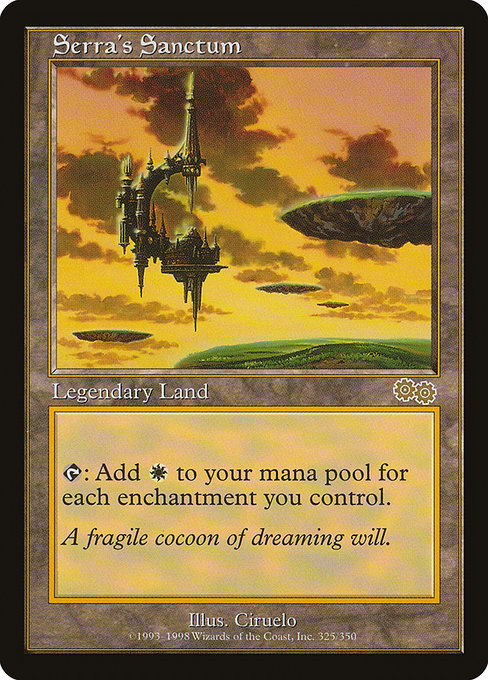
Good for: Enchantment Strategies, Big Mana, Combo
Okay, now that we’ve talked about the not-so-flashy enchantment land, let’s focus on the OG – Serra’s Sanctum.
Considered the least powerful among its brethren (Gaea’s Cradle and Tolarian Academy), being able to add 1 white mana to your mana pool for every enchantment you control is absurd value in a deck revolving around enchantments. Toss in some enchantress pieces, and you’re off to the races.
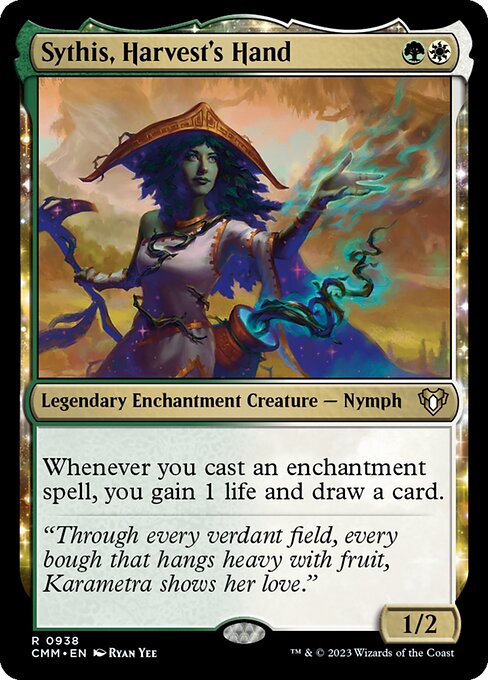
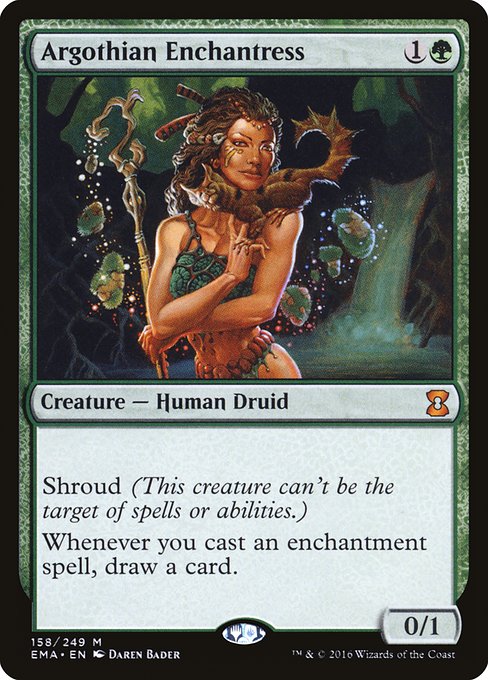
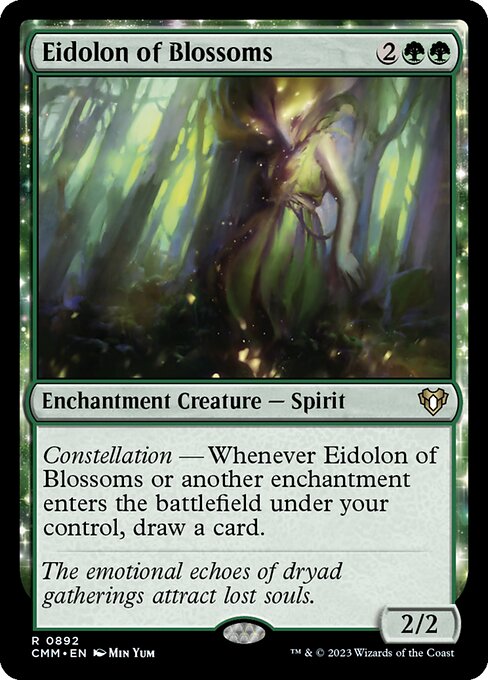
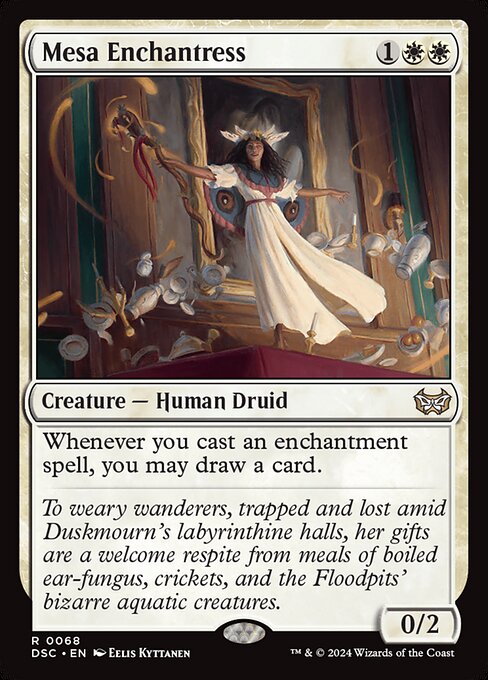
With just a few enchantments in play, this legendary land can help you cast expensive enchantments like Omniscience, fuel mana sinks like Heliod, God of the Sun (which will let it tap for even more on following turns), or combo off with cards like Sanguine Bond and Exquisite Blood.
The absurd level of potential mana generation has ensured a permanent position for Serra’s Sanctum in White enchantment-based decks. Unfortunately, it’s also among the hardest lands to get your hands on thanks to its position on the Reserved List, so you might be bargain hunting for a while if you’re looking for a good deal on this potent land.
Kor Haven: The Peacekeeper
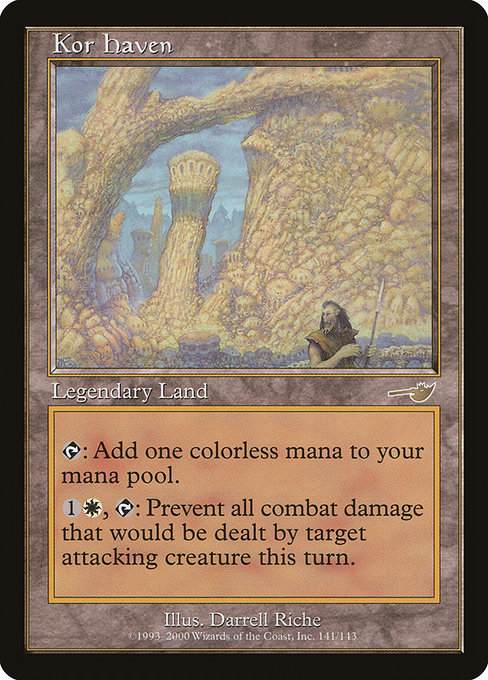
Good for: Pillow Fort, Control, Politics
For the low, low price of 2 mana (3 if you count Kor Haven itself), Kor Haven can prevent all combat damage that a creature would deal in combat. Unlike cards like Maze of Ith and Mystifying Maze, this is done without preventing damage to the attacking creature or removing it from combat, making it a much more versatile and dangerous combat trick for opponents to play around.
While this legendary land is typically used as a way to avoid a big hit from a high power creature, it can be used to help you influence the game by protecting your friends or enemies from attacks, depending on your goals and the current board state.
If table politics aren’t your thing, Kor Haven also really thrives in decks that are already discouraging attacks via effects like Sphere of Safety, Silent Arbiter, or No Mercy, as an attacker that is willing to single out a creature for combat in these situations has usually decided the cost of harming you is worth the price of admission.
Plus, if you’ve been holding mana up for a counterspell that ultimately wasn’t needed during the turn cycle, Kor Haven‘s protection is a great place to sink your excess mana in order to preserve your life total. Add in the fact that it enters untapped (putting it online immediately), and you’ve got a great land and repeatable trick to add to your decks.
Castle Ardenvale: Toss A Token To Your Commander

Good for: Token Strategies, Go Wide, Equipment, Voltron
Castle Ardenvale looks like a mediocre nonbasic land that enters the battlefield tapped at first glance, but the fact that it enters untapped if you control any Plains (basic or otherwise) is a laughably easy barrier to overcome for it to enter untapped in many White decks. Plus it taps for white mana, which is always a plus with White nonbasic lands.
Some of you are probably still looking at me wondering why paying effectively 5 mana (when you include Ardenvale itself) for a 1/1 is worth your time, and if this effect was stapled to anything except a land, I’d be right there with you.
But the fact that this ability is just something extra you have access to for playing the game is what makes it so good.
During early turns, its true you’ll almost never use this effect. But as the game goes on and resources become scarce, the ability to make a blocker or a creature who can carry your Auras and Equipment becomes invaluable. This land has saved me from staring at a board of useless Equipment so many times in my Sram, Senior Edificer deck I’ve lost count at this point.
Decks that like to buff a lot of smaller creatures and win by swarming their opponents will also appreciate this effect, as Anthem effects (cards that boost the power and toughness of all creatures) can mean a 1/1 may be a 3/3 or bigger.
Mix in a token doubler like Anointed Procession, and you suddenly have a threatening board presence over the course of a couple turns.
Having jammed a lot of games with this card over the last few years, Castle Ardenvale plays a lot better than it reads in the decks that want it. And trust me when I say this – the decks that want it really want it.
Eiganjo, Seat of the Empire: The Uncounterable Combat Trick
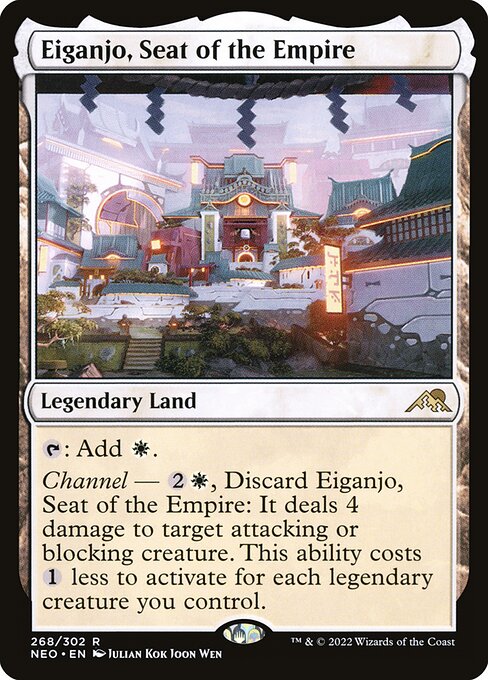
Good for: Legendary Matters, Control, Graveyard Shenanigans, and Most White Decks
Eiganjo, Seat of the Empire reads well right away by entering the battlefield untapped while also tapping for white mana. But it also has a Channel ability while sitting in your hand: Discard and pay 3 mana to inflict 4 damage on an attacking or blocking creature. And the more legendary creatures you have on your side, the cheaper it gets.
Thanks to your commander(s), you should almost always have access to one legendary creature, so you’ll almost always be paying 1 or 2 mana instead of the full 3, but since the Channel effect is an ability and not a spell, it also ducks most countermagic, as well as pesky effects like Dragonlord Dromoka that keep you from casting spells!
Unsurprisingly, Eiganjo, Seat of the Empire thrives that much more in decks that love their legends, including Kethis, the Hidden Hand, who can either help you replay the land after Channeling or use it to access another legendary card, or Captain Sisay, who can tap to fetch this land as a surprise combat trick.
If you have to play Eiganjo as an early land drop, you can also get it back into your hand using lands like Orzhov Basilica and Karoo, and while you are definitely showing off this trick to all of your opponents, there’s enough to keep track of in a game of Commander many will still be blindsided by it if you wait for a couple turns to Channel Eiganjo.
While definitely not considered the best of its land cycle in Kamigawa: Neon Dynasty, the whole series of Channel lands shares a lot of this legendary land’s benefits, meaning Eiganjo, Seat of the Empire is not a card to sleep on for many White Commander decks.
Emeria, Shattered Skyclave: The Angel Factory

Click to flip this card.
Good for: Angel Tribal, Token Strategies, Go Wide, Aggro, Most White Decks
Emeria, Shattered Skyclave is a modal double-faced card (MDFC) that can be played as a sorcery (Emeria’s Call) or a land. Casting it as a sorcery makes a pair of flying 4/4 white Angel Warriors and grants your non-Angel creatures immunity to destruction until you start your next turn. As a land, it enters the battlefield tapped unless you pay 3 life, but taps for white mana.
MDFCs featuring a land on 1 side see a lot of play in Commander despite the inefficient cost of their spell halves due to their nigh-unmatched flexibility. Emeria’s Call is no exception here, as 7 mana for 8 power’s worth of creatures at sorcery speed isn’t anything to write home about, though it can serve as a good finisher for aggressive decks trying to close the game.
But early in the game, this 7 mana bomb doesn’t have to rot in your hand like other expensive cards – you can play it as a tapped land if you have no plays to make, or take 3 damage to get that last mana you need to cast an early commander or mana rock.
This makes Emeria, Shattered Skyclave a relevant draw during most parts of the game, which is a rare claim for cards in MTG. Definitly makes it worthy of being one of the top White lands as far as I’m concerned.
Emeria, The Sky Ruin: The Legendary Graveyard
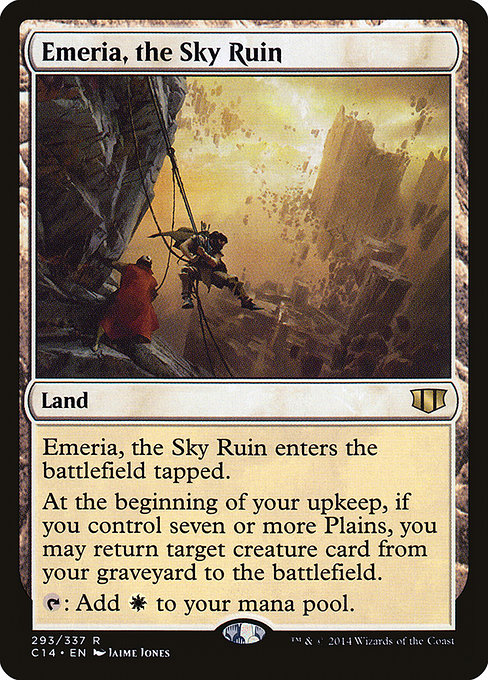
Good for: Reanimation, Value, Control
Emeria, the Sky Ruin is a land that taps for white mana and enters the battlefield tapped, but that’s not why you play it. You play it for its amazing triggered ability that lets you bring back a creature from your graveyard to the battlefield every upkeep, as long as you control seven or more Plains.
Now before we dig into how awesome having a constant reanimation effect on a land is, getting 7 or more Plains into play with Emeria, the Sky Ruin is not always easy – in fact, I’d say this land’s effectiveness has the highest performance variance of all the lands we’ve discussed.
When Emeria is at its best, it wins games, plain and simple. The inevitability of getting high power creatures and potent enter the battlefield effects like Sun Titan, Kokusho, the Evening Star, or Ashen Rider during every one of your turns for 0 mana is backbreaking over time, especially as it means nothing short of an exile effect will permanently keep a threat off the table.
When Emeria is at its worst, it’s a land that enters the battlefield tapped with zero upside. At best, it’s a lightning rod for a Wasteland or Strip Mine from easily spooked opponents. On the bright side, it doesn’t care whether your Plains cards are basic or nonbasic, so that does at least open its relevance up to some multicolor decks running Shocklands, Triomes, and the like.
This frequently tempts me to try Emeria in a deck that can easily get to 7 Plains, as it simply doesn’t care about a creature’s mana cost, power, toughness, or color once it gets going. Cards like Land Tax, Farseek, or Knight of the White Orchid are often already seeing play to accumulate lands anyway, why not add a payoff?
Especially one that can simply be tossed into my manabase without taking up a precious slot for spells!
Conclusion: Waving Goodbye To Subpar Lands
Nonbasic lands are the spices that add flair to our Commander builds and manabases, offering versatility, flavor, and strategic depth. From Ancient Den to Emeria, the Sky Ruin, we’ve revealed some of the best hidden treasures White lands have to offer you.
As you embark on your Commander adventures, remember that nonbasic lands are a tool, not the be-all and end-all. Which ones to include in your deck depends on your playstyle, budget, and in some cases, appetite for risk. Just like crafting a perfect dish, choose wisely, finding the balance of flavors that enhances your deck’s harmony.
Other MTG articles You May Enjoy
- Best White Ramp for Commander
- Best White Board Wipes for Commander
- Best Dual Lands for Commander
- Best Mana Rocks EDH
- Can You Play MTG Solo?
- How to Build a MTG Commander Deck Guide
Braden is a founder of Assorted Meeples and has been a gamer & writer with a vivid imagination all his life. Don’t believe us? Check out his excitement when meeting Goosebumps author R.L. Stine as a kid! An avid Magic: The Gathering spellslinger for over 15 years, you can always convince him to shuffle up for a game (or three!) of Commander.

